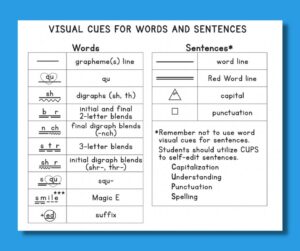Sentence Dictation
Let’s talk about sentence dictation! It’s important that students are transferring knowledge from writing words in isolation to writing words in sentences. How often have you seen children spell a word correctly on a spelling test and then misspell it 5 minutes later when writing? Here are some tips to remember:
- Differentiate: Not all students are going to need visual cues when writing sentences. Maybe some students will need word lines while others may need all of the visual cues. Some students may need some of the words provided on the word lines so that they can trace. Some students can just write their own sentences, paragraphs, and essays! We are giving them the tools they need to help them be successful. Give them what they need and pull back as they are becoming more independent.
- Visual Cues: When providing visual cues, only use word lines, double lines for red words, mountain and a box. Do not use the visual cues that you used for writing words in regards to digraphs, blends, Magic E, etc. Again, we want to see if they can transfer their knowledge of spelling words into writing sentences. Students who cannot write can use index cards to represent words in a sentence and place on word lines.

- Pound and Fingertap: If they are stuck on a word, encourage them to pound and fingertap the word. Help them make the transfer that the skill we taught them in writing words, can transfer to writing words into sentences. Model this for students.
- Remember to state the sentence once. Then pound the syllables in the sentence.
- Then you and your students will pound it.
- Then your students will pound it.
- Next, you will point to the word lines to show where the words will be written.
- Then your students will point.
- Finally, they will write the sentence.
- CUPS: Remember to teach this important self-editing step. Capitalize the beginning of the sentence and proper nouns. Be sure you can understand the sentence. Is it neat? Does it make sense? Place correct punctuation at the end of your sentence. Spell the words correctly.
- Rewrite the sentence. Use CUPS again to be sure all the corrections were made!
- Reread the sentence for automaticity and fluency. Again, students should be able to read fluently without having to sound out every single word.
- Practice, Practice, Practice! Practice writing sentences as often as possible. You can have a writing center where they are practicing the steps to sentence dictation. Record your sentences. Then, have students listen and do the steps without you!
- Using IOG to prepare your dictation sheets is helpful.
- Purchasing an IMSE’s Student Practice Book A, B, or C and IMSE’s K-2 Teacher Guides make this as easy as pulling out a book
It’s our responsibility as educators to help our students see the connection between writing words in isolation and writing words in sentences. We want them to see the connection between spelling and reading. Students think of these subjects as separate areas instead of one connected language.
